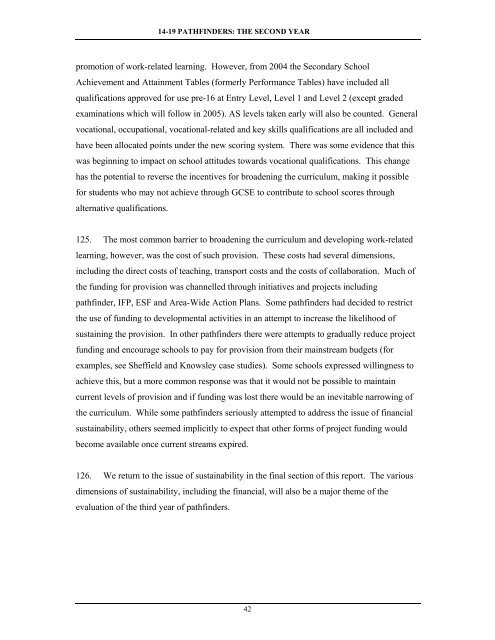Collaborative Approaches to 14-19 Provision - Communities and ...
Collaborative Approaches to 14-19 Provision - Communities and ...
Collaborative Approaches to 14-19 Provision - Communities and ...
- No tags were found...
You also want an ePaper? Increase the reach of your titles
YUMPU automatically turns print PDFs into web optimized ePapers that Google loves.
<strong>14</strong>-<strong>19</strong> PATHFINDERS: THE SECOND YEARpromotion of work-related learning. However, from 2004 the Secondary SchoolAchievement <strong>and</strong> Attainment Tables (formerly Performance Tables) have included allqualifications approved for use pre-16 at Entry Level, Level 1 <strong>and</strong> Level 2 (except gradedexaminations which will follow in 2005). AS levels taken early will also be counted. Generalvocational, occupational, vocational-related <strong>and</strong> key skills qualifications are all included <strong>and</strong>have been allocated points under the new scoring system. There was some evidence that thiswas beginning <strong>to</strong> impact on school attitudes <strong>to</strong>wards vocational qualifications. This changehas the potential <strong>to</strong> reverse the incentives for broadening the curriculum, making it possiblefor students who may not achieve through GCSE <strong>to</strong> contribute <strong>to</strong> school scores throughalternative qualifications.125. The most common barrier <strong>to</strong> broadening the curriculum <strong>and</strong> developing work-relatedlearning, however, was the cost of such provision. These costs had several dimensions,including the direct costs of teaching, transport costs <strong>and</strong> the costs of collaboration. Much ofthe funding for provision was channelled through initiatives <strong>and</strong> projects includingpathfinder, IFP, ESF <strong>and</strong> Area-Wide Action Plans. Some pathfinders had decided <strong>to</strong> restrictthe use of funding <strong>to</strong> developmental activities in an attempt <strong>to</strong> increase the likelihood ofsustaining the provision. In other pathfinders there were attempts <strong>to</strong> gradually reduce projectfunding <strong>and</strong> encourage schools <strong>to</strong> pay for provision from their mainstream budgets (forexamples, see Sheffield <strong>and</strong> Knowsley case studies). Some schools expressed willingness <strong>to</strong>achieve this, but a more common response was that it would not be possible <strong>to</strong> maintaincurrent levels of provision <strong>and</strong> if funding was lost there would be an inevitable narrowing ofthe curriculum. While some pathfinders seriously attempted <strong>to</strong> address the issue of financialsustainability, others seemed implicitly <strong>to</strong> expect that other forms of project funding wouldbecome available once current streams expired.126. We return <strong>to</strong> the issue of sustainability in the final section of this report. The variousdimensions of sustainability, including the financial, will also be a major theme of theevaluation of the third year of pathfinders.42
















